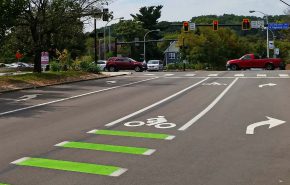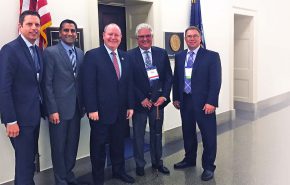At the 2016 Wisconsin ACEC Transportation Improvement Conference in Wisconsin Dells, WI, the Wisconsin Department of Transportation (WisDOT) and GAI Consultants (GAI) presented to a packed crowd during a session titled “Not Your Ordinary Roadway.” Read below for background and details on this unique project located in the Village of Brown Deer in Milwaukee County, WI.
The Representative Project
At the WIS 57/WIS 100 crossing, GAI is evaluating the feasibility of replacing the existing grade separated interchange with an improved service interchange, or an “at grade” intersection. Most transportation engineers would agree that reconstructing an interchange with an “at grade” intersection is extremely rare in our profession.
A Brief History
In early concepts of the Milwaukee freeway system, the WIS 57 project corridor was intended for a different purpose than what it serves today. At different times, two different freeway routes were planned to pass through this corridor, both of which would have required a grade-separated interchange at the crossing. The first planned route was intended to connect Milwaukee to Green Bay on what is today known as I-43 located to the east. The second planned route was an extension of the Stadium Freeway. Public opposition prevented the Stadium extension from ever reaching construction. Despite a freeway corridor never reaching implementation at this location, the WIS 57/WIS 100 crossing was constructed in 1962 as an interchange to meet the requirements of the originally planned use.
Future Vision
The interchange, and more importantly the bridge, is nearing the end of its useful life, so the Department developed a project to reconstruct the interchange with proposed improvements that include reconstructing the existing slab span bridge with a superstructure using concrete girders and desirable vertical clearance, incorporating operational and safety improvements along the underpass and the ramp terminals, and adding bicycle and pedestrian accommodations along all movements.
Finding the Right Solution
Despite these suggested improvements, the project lacked one key item: local support. Village officials viewed the existing interchange as a community divider and a deterrent to investment and community revitalization. The area had seen economic decline in recent years, and this project was an opportunity to connect two principal arterials together in a manner that would align the corridor with the local vision. This local opposition resulted in the development of several alternatives. Different interchange and intersection types were reviewed, but neither the owner nor the locals could agree on the right solution for this location. Then, in early 2015, after a stagnant period of indecision, WisDOT elected to examine all possibilities in an effort to reach a preferred alternative and move the project forward.
ICE Reports: Three Alternatives
The design team completed Intersection Control Evaluation (ICE) reports to document all potential solutions. They reviewed operations, safety, costs, impacts, and feasibility for all ideas. As a result of these evaluations, the team arrived at three alternatives that warranted further investigation, including an Improved Service Interchange, a Traditional “At Grade” Intersection, and a Median U-turn Intersection. The ICE allowed the design team to determine that all three alternatives could be constructed at this location and meet operational requirements, have reasonable and comparable costs/impacts, and be feasible for the location.
IHSDM Software for Crash Predictions
In order to further investigate safety at the intersection, a comprehensive review of crash history and an analysis of crash prediction was performed. GAI utilized the Interactive Highway Safety Design Module (IHSDM) to perform the crash prediction of the existing geometrics of the interchange. IHSDM was developed by the Federal Highway Administration (FHWA) to apply the methods of the recently developed Highway Safety Manual (HSM). GAI worked closely with FHWA during the process to develop models that could be utilized for crash prediction. Baseline models for the existing interchange were developed and compared with historical crash data for the project location in order to validate the methodology. Additional coordination with FHWA was necessary because IHSDM input requires alternative modification factors based on historical data. There is limited information regarding conversions of existing interchanges to “at grade” intersections, and while U-turn intersections are better studied than interchange to “at grade” conversions, median U-turn intersection studies are also limited.
Other Analyses and Outreach
In addition to ICE metrics, GAI reviewed additional variables for the three alternatives. The team completed a sensitivity analysis to evaluate each alternative’s additional capacity for traffic growth. GAI also performed extensive agency outreach for the median U-turn alternative, because a median U-turn has never been constructed in the State of Wisconsin. In the event that a median U-turn alternative is selected for this location, WisDOT wants to learn from other agencies’ experiences.
What’s Next?
Prior to selecting a preferred alternative, the next step for the project is public involvement. WisDOT and GAI are working toward an April 2016 Public Involvement Meeting with an elected alternative expected shortly thereafter.
For questions or additional information about this “at grade” intersection project, contact GAI Consultants at 262.250.8000.


